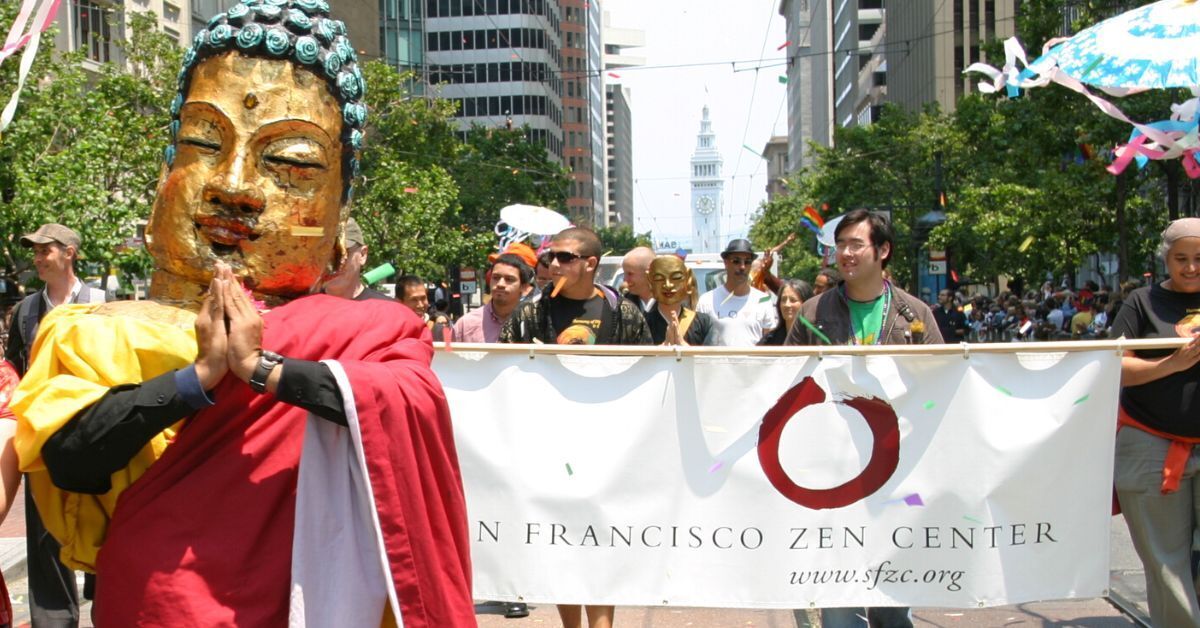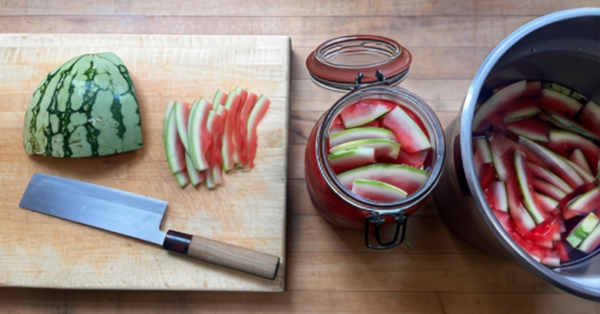
On June 26, after a several year hiatus, San Francisco Zen Center will again have a contingent in the LGBTQIA+ Pride Parade. We invite readers of this article to join us if you’re in the Bay Area. The theme of this year’s parade is “Love Will Keep Us Together.”
San Francisco Zen Center first had a contingent in the Pride Parade in 2008. It was a joyful event.
That year the LGBTQIA+ community and allies were organizing to protest against Proposition 8, which would ban same-sex marriage in California. Several City Center residents wanted to march in solidarity with the LGBTQIA+ community, and were supported by SFZC’s leadership to do so. Many of us joined the march.
Our contingent was led by a magnificent Buddhawith a large painted papier mache head crafted by Berkeley artist Annie Hallatt and a flowing maroon robe. The Buddha was guided by an attendant in black robes (it was hard to see through the mask), and followed by Zen students and friends on foot and aboard a decorated truck. Blanche Hartmann, our former Abbess, sat Zazen on an inverted milk crate as we slowly wheeled along the parade route, while those of us on the truck bowed and waved to the crowds lining both sides of Market Street.
We participated in the parade annually, often coming together later in the afternoon for a period of meditation in the City Center Buddha Hall, led by Larry Yang ( co-founder of the East Bay Meditation Center in Oakland) and myself.
A bit of history: The Stonewall Riots, also called the Stonewall Uprising, began in the early hours of June 28, 1969 when New York City police raided the Stonewall Inn, a gay club located in Greenwich Village in New York City. The raid sparked a riot among bar patrons and neighborhood residents as police roughly hauled employees and patrons out of the bar, leading to six days of protests and violent clashes with law enforcement outside the bar on Christopher Street, in neighboring streets and in nearby Christopher Park. The Stonewall Riots served as a catalyst for the gay rights movement in the United States and around the world. The first pride parades (in New York, San Francisco, and elsewhere) occurred a year later, on June 28, 1970.
I first marched in a pride parade in Boston in the late 70’s, with a gay friend who had just learned that he was HIV positive. For my friend, who experienced being HIV positive as a death sentence (which it was for many gay men at that time) marching in the parade was a joyful expression of being alive. For me, it was an antidote to the loneliness I had felt in my adolescence and early adulthood. Coming out had been a difficult process for me. I kept getting messages that there was something wrong with me for loving women. I didn’t know other lesbian women; most were closeted.
Marching in that Boston pride parade was exhilarating as we celebrated together — all genders, old and young, same-gendered parents with their children, friends and parents of lesbians and gay men with their PFLAG banner. Bells rang as we walked by the Arlington Street church and people looked out of their windows waving, or cheered from the sidewalks.
I moved to the Bay Area in 1990 at the invitation of a woman I loved, and a year later we had a ceremony of commitment on Pride weekend. It was as if the entire city was celebrating with us.
I have missed participating in the Pride parade these past two years when it was canceled due to Covid. This year’s parade theme, “Love Will Keep Us Together,” seems deeply relevant in this time, when states are passing legislation that bans information about sexual orientation or gender identity in some grades, or prohibits parents from acknowledging the needs of their non-binary or transgender children.
This year, we are looking for marchers, planners, decorators, and safety monitors. We will leave from the steps of 300 Page Street in San Francisco at 9:30am and take Muni to our assigned spot (TBA). For further information, contact choku.proudfoot@sfzc.org. You can also register online.
By Tova Green











